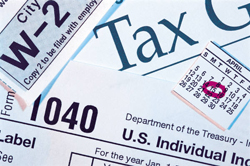 With tax time upon us, you may want to take a look at AOPA’s Pilot’s Guide to Taxes to see if your flying activity might qualify for a deduction. Read up on tax concerns that affect aircraft owners, particularly those who use their aircraft for business purposes. Some flight training expenses may qualify for a tax break if they are trade or business related. Are you familiar with the Hobby Loss Rule? The guide provides details about the rule, as well as several cases and rulings to clarify its interpretation. Are you leasing, or considering leasing an aircraft? The guide will give you some general insights on the tax aspects of aircraft leasing. The Q and A section answers many common tax questions, and there is additional information on sales and use taxes, and personal property taxes. Here are some further details.
With tax time upon us, you may want to take a look at AOPA’s Pilot’s Guide to Taxes to see if your flying activity might qualify for a deduction. Read up on tax concerns that affect aircraft owners, particularly those who use their aircraft for business purposes. Some flight training expenses may qualify for a tax break if they are trade or business related. Are you familiar with the Hobby Loss Rule? The guide provides details about the rule, as well as several cases and rulings to clarify its interpretation. Are you leasing, or considering leasing an aircraft? The guide will give you some general insights on the tax aspects of aircraft leasing. The Q and A section answers many common tax questions, and there is additional information on sales and use taxes, and personal property taxes. Here are some further details.
Income Taxes
The section on income taxes discusses the kinds of aircraft expenses that qualify for a deduction based on ordinary and necessary operating expenses incurred while the aircraft is used in conjunction with a business. It is the taxpayer’s responsibility to prove entitlement to whatever deductions are taken. Since the governing tax law is broadly worded, several cases and rulings are summarized in an effort to provide clearer understanding of how the law is interpreted and applied. The guide suggests a few ways to prevent (or deal with) problems with the IRS, and also identifies which tax forms to use for specific situations.
A 2008 stimulus package for aircraft purchased in 2008, which are used to conduct a trade or business, allows for a faster depreciation, referred to as a 50-percent bonus depreciation or as Section 179 expensing that you and your tax professional may want to analyze for the 2008 tax year. The 2008 deduction amounts and some information on their limitations are discussed in the tax guide. The Economic Stimulus Bill, which President Obama signed into effect on February 17, 2009 extends these benefits for aircraft purchased in 2009. Contact your tax professional for advice.
Flight Training Expenses
AOPA members frequently ask whether they can take a tax deduction for the cost of their flight training. Flight training expenses are deductible only if they are trade or business related. Unfortunately, Uncle Sam won’t allow a tax break for those of us who take flight training purely for personal achievement and satisfaction.
IRS regulations allow deductions for educational expenses under certain conditions: If the education (1) maintains or improves skills required in your employment, trade, or business; or (2) meets the express requirements of your employer or the requirements of applicable law or regulations imposed as a condition for your retention of salary, status, or employment (IRC Regulation §1.162-5(a)). But here’s the caveat: even if educational expenses meet one of these two tests, they will still be nondeductible if they are incurred to meet the minimum educational requirements for your employment or if the education qualifies you for a new trade or business (IRC Regulation §§1.162-5(b)2 and 3).
So, what does this mean? Here are a couple of examples from the guide. If you are training to become a flight instructor, the training expenses you incur in getting your initial flight instructor certificate will not be deductible, because holding that certificate is the minimum educational requirement for employment as a flight instructor. However, if you already are a flight instructor and you attend a flight instructor refresher clinic, your course expenses should be deductible.
The Hobby Loss Rule
What in the world is the hobby loss rule? Tax deductions apply to endeavors undertaken with the intent of making a profit—and the IRS won’t allow a write-off of losses incurred while engaged in a hobby. Many of our members are using or would like to use an aircraft in an aviation-related business. The types of businesses involved include aircraft rentals, flight instruction, aerial photography, banner towing, and a host of other activities that involve the use of an aircraft. If you've ever considered putting an aircraft to work for you in a business, be aware that Internal Revenue Code (IRC) Section 183 (the “hobby loss rule”) applies to individuals, LLCs, and subchapter S corporations. If the IRS determines that your aviation activity is a hobby, expenses related to the activity are deductible only to the extent of the gross income from the hobby activity. To help you look at your flying activity through the eyes of the tax man, the guide provides the nine factors IRS uses to decide whether an activity is considered “for profit,” thus qualifying it for a tax break. Summaries of cases and rulings provide examples that help clarify the interpretation of this rule.
Aircraft Leasing
AOPA members often lease their aircraft in order to defray ownership costs. If you are already leasing your aircraft or if you're thinking about leasing your aircraft, this section of the guide will be helpful as it offers some general insights on the tax aspects of aircraft leasing.
As discussed above, the first thing to keep in mind is that your aircraft leasing activity should be supported by an honest intent on your part to make a profit. Remember, if the IRS sees your aircraft leasing activity as a way to help support your flying hobby, you will not be allowed to take tax deductions on any losses you incur in your leasing activity.
Of course, if your aircraft leasing activity is generating some revenue, there are very few tax complications. The IRS is generally content to take their share of your profit! But, what if your leasing activity is not turning a profit? The first thing you should know is that you cannot take a loss deduction for any amounts that exceed what the IRS considers you to be at risk for in your aircraft leasing activity. Generally speaking, you are considered at risk in an activity to the extent of the cash and the adjusted basis (tax value) of other property you contributed to your aircraft leasing activity. Your at-risk amounts will also include amounts that you borrowed for use in the aircraft leasing activity if you are personally liable for the repayment of the borrowed amounts or the amounts borrowed are secured by property other than your aircraft. Therefore, in many cases, if you purchased an aircraft for cash, credit, or a combination of both, you would be considered to be at risk for the amount of the aircraft's purchase price.
Once you've determined your allowable losses after applying the at-risk rules, you’ll have to consider whether the IRS's passive activity loss rules will apply to your aircraft leasing activity. The passive activity loss rules were put into effect in 1987 in an effort by Congress to curb what they considered to be abusive tax shelters. It gets complicated, as you can see, and the advice of a tax professional is highly recommended when applying tax rules to your particular leasing situation.
Questions
The guide has a Q and A section that answers many common tax questions, and it also provides information on sales and use taxes, and personal property taxes. Have more questions? Give the aviation technical specialists in AOPA’s Pilot Information Center a call Monday thru Friday, 800/872-2672.
And please remember—AOPA’s tax guide is meant to provide information, but should not be used as a substitute for your own tax professional!



